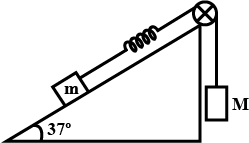
A block of mass m is attached to a massless spring of force constant k. The block is placed over a rough inclined surface for which the coefficient of friction is $\mu =\dfrac{3}{4}$ . The minimum value of M required to move the block up the plane is (Neglect mass of string and pulley and friction in pulley):

$\begin{align}
& (a)\dfrac{3}{5}m \\
& (b)\dfrac{4}{5}m \\
& (c)2m \\
& (d)\dfrac{3}{2}m \\
\end{align}$

Answer
524.4k+ views
Hint: We will first write the force equation on the small block (m) to get the required length of spring that must stretch down in order to just move the block up the inclined surface. We will then apply the Work Energy theorem for conservation of energy on the small block (m) to get the required solution.
Complete answer:
Let the mass $M$ descend $x$ meters to just move the block up on the incline. Then, writing the force equation on block M in the vertical direction, we get:
$\Rightarrow Mg=kx$
Where,
$kx$ is the spring force.
Now, for the small block (m) , force acting on it along the inclined surface are:
$kx$ : force due to the spring, up the incline
$mg\sin \theta $: down the incline
$\mu mg\cos \theta $: down the incline
Thus, the net force on the block can be written as:
$\begin{align}
& \Rightarrow kx=mg\sin \theta +\mu mg\cos \theta \\
& \Rightarrow kx=mg(\sin \theta +\mu \cos \theta ) \\
\end{align}$
Here, it has been given to us:
$\begin{align}
& \Rightarrow g=10m{{s}^{-2}} \\
& \Rightarrow \mu =\dfrac{3}{3} \\
& \Rightarrow \sin \theta =\dfrac{3}{5} \\
& \Rightarrow \cos \theta =\dfrac{4}{5} \\
\end{align}$
Putting these values in the above equation, we get:
$\begin{align}
& \Rightarrow kx=10m\left( \dfrac{3}{5}+\dfrac{3}{4}\times \dfrac{4}{5} \right) \\
& \Rightarrow kx=10m\left( \dfrac{6}{5} \right) \\
& \Rightarrow kx=12m \\
\end{align}$
Now, applying the Work-Energy theorem:
$\Rightarrow {{W}_{gravity}}+{{W}_{spring}}+{{W}_{friction}}=\vartriangle K.E.$
Here,
$\begin{align}
& \Rightarrow {{W}_{gravity}}=Mgx \\
& \Rightarrow {{W}_{spring}}=\dfrac{1}{2}k{{x}^{2}} \\
& \Rightarrow {{W}_{friction}}=0 \\
& \Rightarrow \vartriangle K.E.=0 \\
\end{align}$
Putting these values in above equation, we get:
$\begin{align}
& \Rightarrow Mgx+\left( -\dfrac{1}{2}k{{x}^{2}} \right)+0=0 \\
& \Rightarrow M=\dfrac{kx}{20} \\
\end{align}$
Using the value of $kx$ calculated above, we get the value of M as:
$\begin{align}
& \Rightarrow M=\dfrac{12m}{20} \\
& \Rightarrow M=\dfrac{3m}{5} \\
\end{align}$
Hence, the minimum value of M to move the block up the incline should be $\dfrac{3m}{5}$
Hence, option (a) is the correct option.
Note:
It should be noted that, in the problem the statement was “just to move the block up”. This means that the block did not gain any velocity in the process and that it has been moved very slowly. This is the reason why, in the Work-Energy equation we wrote the value of change in kinetic energy of the block as zero and not something finite.
Complete answer:
Let the mass $M$ descend $x$ meters to just move the block up on the incline. Then, writing the force equation on block M in the vertical direction, we get:
$\Rightarrow Mg=kx$
Where,
$kx$ is the spring force.
Now, for the small block (m) , force acting on it along the inclined surface are:
$kx$ : force due to the spring, up the incline
$mg\sin \theta $: down the incline
$\mu mg\cos \theta $: down the incline
Thus, the net force on the block can be written as:
$\begin{align}
& \Rightarrow kx=mg\sin \theta +\mu mg\cos \theta \\
& \Rightarrow kx=mg(\sin \theta +\mu \cos \theta ) \\
\end{align}$
Here, it has been given to us:
$\begin{align}
& \Rightarrow g=10m{{s}^{-2}} \\
& \Rightarrow \mu =\dfrac{3}{3} \\
& \Rightarrow \sin \theta =\dfrac{3}{5} \\
& \Rightarrow \cos \theta =\dfrac{4}{5} \\
\end{align}$
Putting these values in the above equation, we get:
$\begin{align}
& \Rightarrow kx=10m\left( \dfrac{3}{5}+\dfrac{3}{4}\times \dfrac{4}{5} \right) \\
& \Rightarrow kx=10m\left( \dfrac{6}{5} \right) \\
& \Rightarrow kx=12m \\
\end{align}$
Now, applying the Work-Energy theorem:
$\Rightarrow {{W}_{gravity}}+{{W}_{spring}}+{{W}_{friction}}=\vartriangle K.E.$
Here,
$\begin{align}
& \Rightarrow {{W}_{gravity}}=Mgx \\
& \Rightarrow {{W}_{spring}}=\dfrac{1}{2}k{{x}^{2}} \\
& \Rightarrow {{W}_{friction}}=0 \\
& \Rightarrow \vartriangle K.E.=0 \\
\end{align}$
Putting these values in above equation, we get:
$\begin{align}
& \Rightarrow Mgx+\left( -\dfrac{1}{2}k{{x}^{2}} \right)+0=0 \\
& \Rightarrow M=\dfrac{kx}{20} \\
\end{align}$
Using the value of $kx$ calculated above, we get the value of M as:
$\begin{align}
& \Rightarrow M=\dfrac{12m}{20} \\
& \Rightarrow M=\dfrac{3m}{5} \\
\end{align}$
Hence, the minimum value of M to move the block up the incline should be $\dfrac{3m}{5}$
Hence, option (a) is the correct option.
Note:
It should be noted that, in the problem the statement was “just to move the block up”. This means that the block did not gain any velocity in the process and that it has been moved very slowly. This is the reason why, in the Work-Energy equation we wrote the value of change in kinetic energy of the block as zero and not something finite.
Recently Updated Pages
Master Class 11 Chemistry: Engaging Questions & Answers for Success

Why are manures considered better than fertilizers class 11 biology CBSE

Find the coordinates of the midpoint of the line segment class 11 maths CBSE

Distinguish between static friction limiting friction class 11 physics CBSE

The Chairman of the constituent Assembly was A Jawaharlal class 11 social science CBSE

The first National Commission on Labour NCL submitted class 11 social science CBSE

Trending doubts
What is meant by exothermic and endothermic reactions class 11 chemistry CBSE

10 examples of friction in our daily life

One Metric ton is equal to kg A 10000 B 1000 C 100 class 11 physics CBSE

Difference Between Prokaryotic Cells and Eukaryotic Cells

What are Quantum numbers Explain the quantum number class 11 chemistry CBSE

1 Quintal is equal to a 110 kg b 10 kg c 100kg d 1000 class 11 physics CBSE




